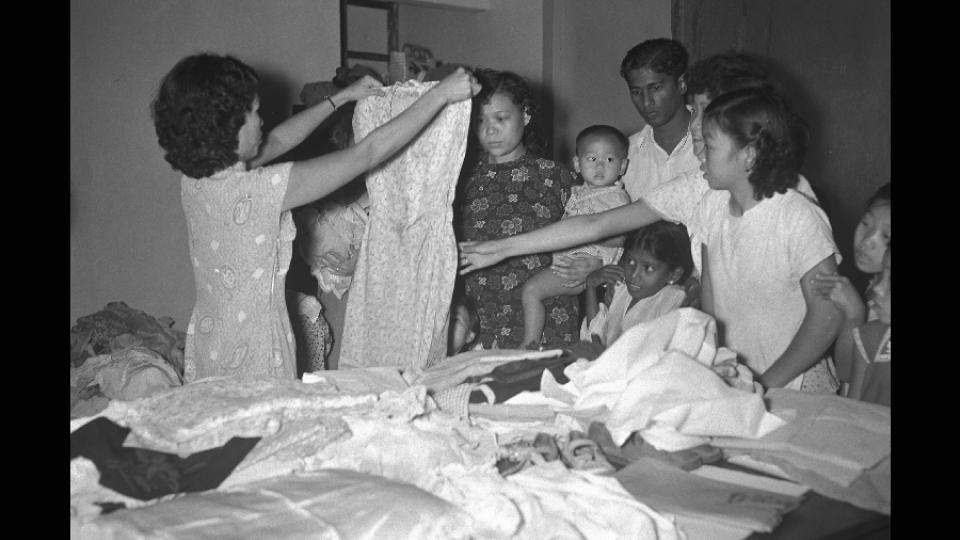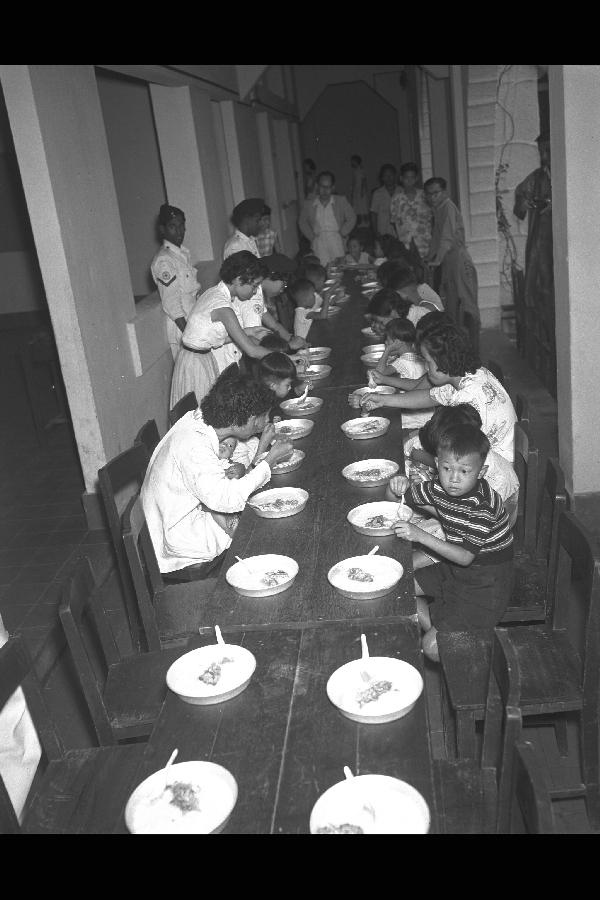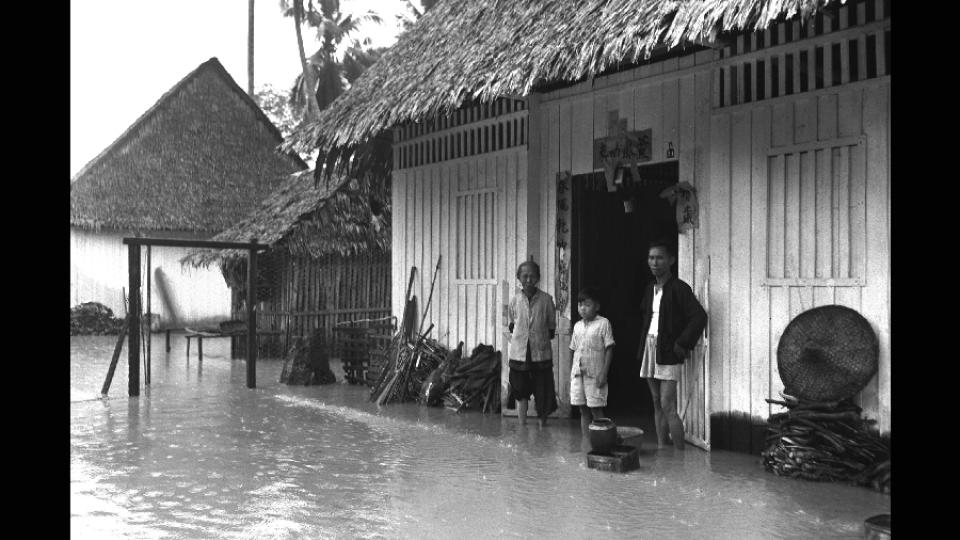A combination of torrential and prolonged rains, high tides, and insufficient flood control caused some of the worst flooding known in Singapore in the first two weeks of December 1954. Early 1950s Singapore was a British Crown Colony and part of the Federation of Malaya. It was a particularly tense time politically, with the rise of nationalist movements and an ongoing state of “emergency” declared by the British government in response to a perceived communist threat supported by some members of the Chinese community. The 1954 floods were a disaster that piled more pressure onto an already stressed community. More than 10,000 people were affected; 5,000 were temporarily or permanently displaced. Five people died on the night of the 17 December when their rescue boat capsized—the first victims of the disaster. The worst affected areas were also some of the poorest: kampong (rural village) communities on the north and eastern fringes of the city, including Potong Pasir, Braddell Road, Lorong Tai Seng, Geylang Serai, and Bedok. Immediate disaster response, medium-term rehabilitation, and long-term improvements to flood mitigation works amounted to hundreds of thousands of Straits dollars.
Relief operations were run on a massive scale and involved the government, the Social Welfare Department (SWD), the Royal Malayan Navy and Army, Royal Air Force, Salvation Army, St. John’s Ambulance, the police, and community volunteers. Schools, churches, and community halls were set up as emergency shelters. Special flood relief funds were established by the government, Chinese associations, the Chinese Chamber of Commerce, and newspapers. The Straits Times fund alone had raised 278,000 Straits dollars by the end of the month. Two-hundred and fifty tons of rice were given by the Thai and Burmese governments. Money, clothes, tinned milk, rice, poultry, and fertilisers were also donated.
At a temporary relief center set up at St. Andrew’s School Lee Teck Ping, a junior teacher, told how the previous week they had four hundred people living in their school hall from villages off Potong Pasir. They had sent people out to collect them in boats and the St. John’s Ambulance looked after the sick but many had been living in flooded conditions for some time. Staff and students were lauded as heroes by the local press.
Despite extensive efforts at coordinated relief work, however, there was a perception that the government and council were not doing enough to help, according to articles from The Straits Times. One inhabitant of Geylang Serai told his story. Forced to flee rising floodwaters, he had spent one night at a temporary shelter provided by the SWD where he registered to receive aid. Unable to stay longer and with his house knee-deep in water, he had no choice but to spend the next few nights with his son, a police officer, in the barracks. When he tried to receive his aid entitlement he was turned away: twice. To rub salt into the wound, the two days spent trying to claim aid meant two days’ lost work.
For the inhabitants of Bedok, this flood was their third that year. The problem was so bad that the community had instituted their own support mechanism: the Bedok Village Flood Relief Committee. The inhabitants argued that a lack of governmental foresight and planning had exacerbated their community’s misfortune.
Bedok was a resettlement project, where inhabitants, mainly farmers, had been forcibly moved to clear land needed for a government sponsored airfield at Paya Lebah. The Committee became the villagers’ mouthpiece. Writing to the Colonial Secretary on 19 January 1955, they explained that
the flood was a blow which fell just as we were starting to recover from the October flood…we had protested against the unsuitability of Bedok and had pointed out that the area would flood easily…many of us are now in debt.
The post-flood political fallout reflected the mood of the people. Despite investment in major flood mitigation schemes instigated by the government and enacted over the course of 1955-56, the experience contributed to a growing anti-colonial narrative. Though unrelated, 1954 also witnessed the formation of the People’s Action Party (PAP); riots over national service, and strikes by day laborers against the city council. Whilst it would be too strong to state that the flood directly impacted politics, it is interesting to note that political opposition candidates who had been active in the post-1954 cleanup were elected in the spring 1955 general election. Criticism of the government’s handling of the December floods and poor water management may not have been the cause, but they added fuel to the fire. Malaya gained independence in 1957.
How to cite
Williamson, Fiona. “A Milestone on the Road to Independence? Singapore’s Catastrophic 1954 Floods.” Environment & Society Portal, Arcadia (Autumn 2016), no. 13. Rachel Carson Center for Environment and Society. https://doi.org/10.5282/rcc/7677.
ISSN 2199-3408
Environment & Society Portal, Arcadia
 This work is licensed under a Creative Commons Attribution 4.0 International License.
This work is licensed under a Creative Commons Attribution 4.0 International License.
2016 Fiona Williamson
This refers only to the text and does not include any image rights.
Please click on an image to view its individual rights status.
- Bankoff, Greg, George Frerks, and Dorothea Hilhorst. Mapping Vulnerability: Disasters, Development, and People. London: Earthscan, 2004.
- Barr, Michael D., and Carl A. Trocki. Paths Not Taken: Political Pluralism in Post-War Singapore. Singapore: NUS Press, 2008.
- Colony of Singapore. Annual Report. 1954.
- Mauch, Christof, and Christian Pfister, eds. Natural Disasters, Cultural Responses: Case Studies toward a Global Environmental History. Lanham: Lexington Books, 2009.
- National Archives of Singapore (NAS), Public Relations Office 15, 671/54: Letter from the Acting Chairman of the Bedok Village Flood Relief Committee to the Colonial Secretary, 19 January 1955.
- National Archives of Singapore (NAS), Public Relations Office 15, Singapore, 671/54 Singapore Floods 1954-6: Press Statement FE.55/11, 3 February 1955; JA. 55/95 29 January 1955.
- National Archives of Singapore (NAS), Public Relations Office 15 671/54: Letter from Francis Thomas, Minister for Communications and Works to the Editor, 31 January 1956.
- Log in to post comments
- Print page to PDF











